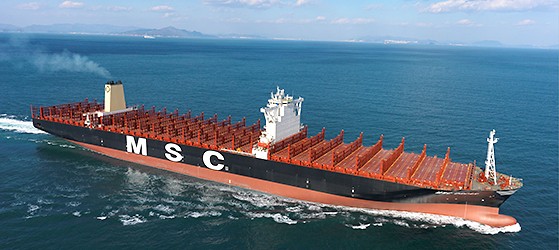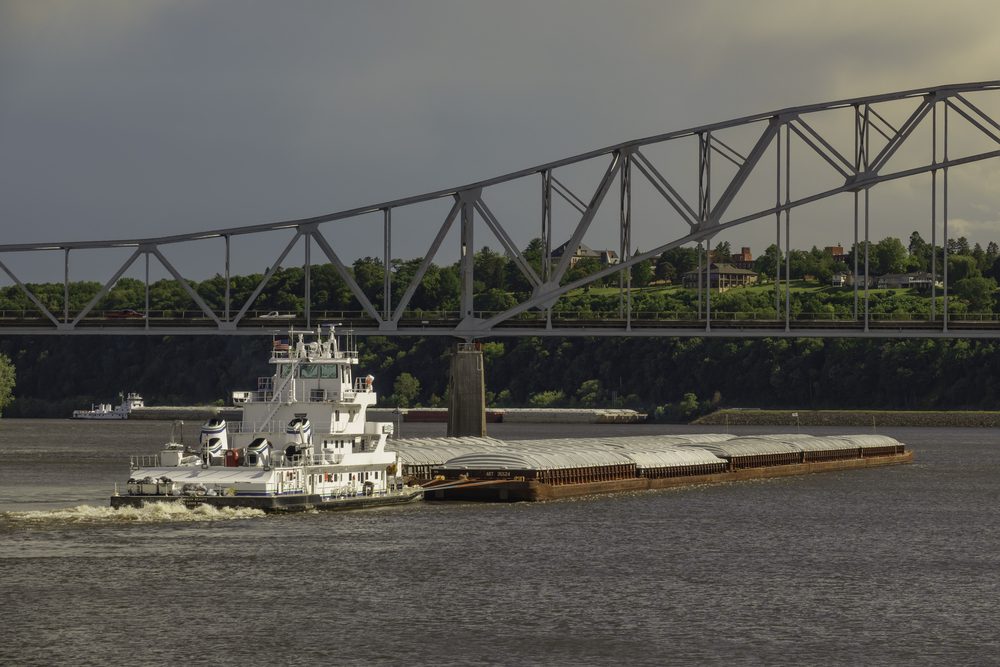MSC Oscar has a nominal capacity of 19,224 TEUs, the most of any ship currently in operation. Photo courtesy DNV GL
By Kyunghee Park
(Bloomberg) — This is how much size matters in the shipping industry: Bragging rights for the world’s largest container ship have changed hands four times in as many months – – and will soon shift again.
With weak freight rates encouraging shipping lines to send as many goods as possible in a single voyage, Samsung Heavy Industries Co., the world’s third-biggest shipbuilder, is constructing four vessels capable of carrying 20,100 20-foot containers — enough to fit about 203 million iPads — for Mitsui O.S.K. Lines Ltd. of Japan.
The seaborne arms race comes even as overcapacity has led to a plunge in shipping rates since late 2010 and four straight years of losses for the industry. Some lines have responded by driving their vessels more slowly to save fuel and by scrapping older, less efficient ships. Others have decided to go as large as possible to cut costs by as much as 30 percent per voyage.
“Shipping companies are favoring bigger ships because of the benefits. With bigger ships you can move more goods at one go, helping to reduce your costs.” said Park Moo Hyun, an analyst at Hana Daetoo Securities Co. in Seoul. “But at the same time, it raises concerns about whether these ships can be filled.”
Mitsui O.S.K. will receive its new ships from Samsung Heavy by August 2017. The vessels will be 400 meters long — equal to four soccer fields, longer than the Eiffel Tower is tall — and 58.8 meters wide, Samsung Heavy said March 2. They also will have fuel-saving features.
Samsung Heavy expects more 20,000-container vessels will be ordered in the first half of this year because of the economies of scale they offer, the company said in an e-mail to Bloomberg.
Mitsui O.S.K. believes switching to larger ships “will enhance our competitiveness,” Tetsutaro Kozai, assistant manager of the company’s public relations office, said in an e- mail to Bloomberg. The company expects the ships it ordered from Samsung “will be the largest in operation for some time,” he said.
Whether ship sizes continue to grow depends on builders finding ways to make even larger vessels that will be structurally sound amid the punishment of rough seas. Ports will need ever-deeper shipping lanes and terminal operators will require cranes capable of stretching all the way across the wider decks.
That could be a problem for ports on the U.S. West Coast, where Los Angeles and Long Beach, California can’t handle ships holding more than about 12,000 containers. That — plus the fact that there are no ports of call between Asia and the U.S. West Coast — means the supersize vessels mainly ply Asia-Europe routes.
A.P. Moeller-Maersk A/S started the recent trend toward bigger vessels in 2011 when it ordered 20 “Triple-E” ships from Daewoo Shipbuilding & Marine Engineering Co. At the time they were the biggest vessels in the world, capable of carrying more than 18,000 20-foot containers each.
A ship of that size can cut costs by about 30 percent per trip compared to a 13,000-box ship, based on a bunker fuel price of $600 a ton, according to Drewry Maritime Equity Research. Even at current fuel prices — $395.59 a ton as of Wednesday in Singapore — a larger vessel is still about 15 percent cheaper per voyage, Drewry said.
Most vessels used now on the Asia-Europe route can fit 14,000 containers, according to Park at Hana Daetoo. There currently are more than 100 of these ships in service, he said.
Maersk Line, the world’s largest container shipping company, currently operates 15 Triple-Es and expects five more to be delivered in the first half of this year.
“Maersk moved the market with big ships, and people are seeing Maersk’s results,” said Rahul Kapoor, a Singapore-based director for equity research at Drewry. “So people are thinking that’s the way to go forward.”
Maersk Line doubled its after-tax operating profit in the fourth quarter of 2014, to $655 million. Maersk Line will soon place its first order for new ships since 2011, probably in the first half of this year, Nils Smedegaard Andersen, chief executive officer of A.P. Moeller, said last month.
“We may order Triple-E ships, but don’t expect an order of 20 or 30 ships this year because we need to time it carefully so we grow with the market,” Andersen said last month.
The Triple-Es didn’t keep Maersk Line on top of the size rankings for long: China Shipping Container Lines Co. took the title in November with a ship able to carry 19,100 20-foot containers. That was overtaken barely a month later when Mediterranean Shipping Co. launched a ship able to carry 19,224 containers.
In late January, Imabari Shipbuilding Co. received an order for 11 ships capable of carrying 20,000 containers. Those briefly became the world’s biggest planned ships — until Mitsui O.S.K. placed its order this week.
Driving the push for size is the collapse of shipping rates over the past four years. Spot cargo shipping rates to Europe from Asia dropped to $938 per container in the week ended Feb. 27, down 6.5 percent from two weeks earlier and 15 percent lower than at the end of February 2014, according to the Shanghai Shipping Exchange.
Shipping lines have tried to raise rates in recent months, largely without success, and some are trying again to raise rates from March 15, according to shipping-data provider Alphaliner. If anything, though, slowing global demand and new vessels set to enter service this year could drive levies even lower, Alphaliner said in its weekly newsletter.
Hyundai Heavy Industries Co., Daewoo Shipbuilding and Samsung Heavy — the world’s three-biggest shipbuilders — have the technology to build ships that can carry as many as 25,000 boxes, suggesting that the title of world’s largest ship will soon shift again.
“There’s no end to it. You will have someone soon displace Mitsui O.S.K. as the largest shipowner,” Drewry’s Kapoor said. “The container shipping industry has always been like they all want to follow the lead. That’s the competitive intensity that’s driving this.”
Copyright 2015 Bloomberg.

 Join The Club
Join The Club











